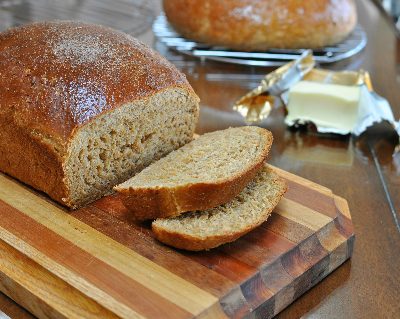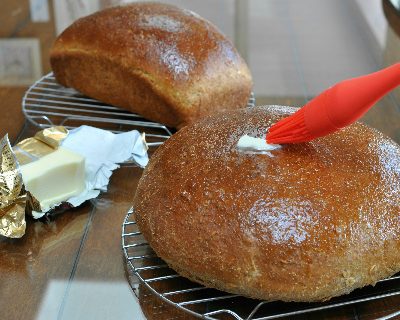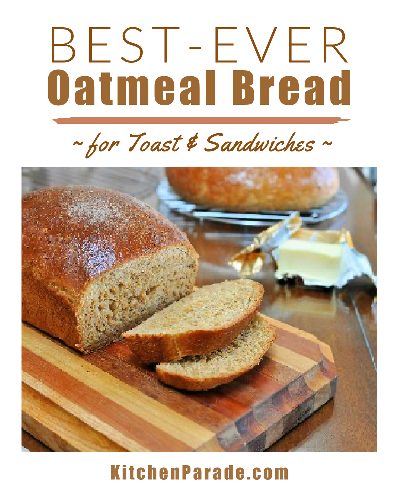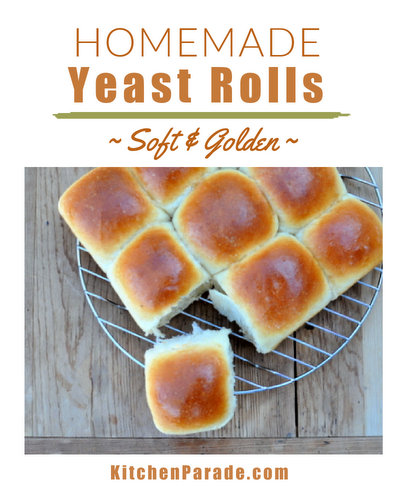| Best-Ever Oatmeal Bread |  |
Fresh Bread, Made from Scratch. Great Choice for Toast, Skillet Toast & Sandwiches. Hearty & Filling. Potluck & Party Friendly.
COMPLIMENTS!
- "This was very good." ~ acr

In My Family, Bread Is Special. It Means Much More Than the Bread Itself.
A week ago, my friend Tricia lost her mom.
A week ago would have been my mom's 77th birthday. Even before hearing of Tricia's loss, I planned to pay tribute to Mom, as I do every year, by making bread on her birthday.
When I was growing up, my mother made bread every week. It was therapeutic: a way to feed her family and heal her soul while recovering from a radical mastectomy at only age 35, a way to exercise muscles irrevocably cut and weakened by surgery. She felt satisfaction knowing her labor – her pain – would nourish her family physically and spiritually.
For years, Mom mixed dough in a huge cream-colored ceramic bowl with soft pink and aqua stripes. Later she downscaled – her favorite bread bowl became a gallon plastic ice cream bucket! (More about that here, with the recipe for Homemade Yeast Rolls aka My Mom's "Ice Cream Pail" Buns.)
Then many years later, when my mom was sick with lung cancer and my family was caring for her in my home, I too made bread, this bread.
We came to call it Best-Ever Oatmeal Bread, learning that the aroma of baking bread attracts a crowd to the kitchen, eagerly awaiting the moment when the loaves are cool enough to cut into thick slices and slather with fresh butter.
It was Kitchen Parade's second recipe in 2002, fitting, for sure, since my mom first began writing Kitchen Parade when I was a baby and it was only after her death that I decided to follow in her footsteps.
So after hearing my friend Tricia's news, I knew that after mixing and kneading and tending and shaping and baking and tapping and buttering, I would deliver warm bread to a family raw with loss, gathering with memories, communing with tears and laughter, mourning their loss, celebrating the life of their own mother.
A Forgiving Bread
Best-Ever Oatmeal Bread is a forgiving and adaptable recipe.
I’ve intentionally (or accidentally) doubled the molasses and honey, omitted the pecan meal or the milk powder, used almond meal instead of pecan meal, substituted all-purpose flour for a portion of the bread flour, added dried cranberries or sunflower seeds, and so on.
So – follow the recipe the first time, then start experimenting.
Like all bread, it's delicious straight from the oven. But a loaf stays fresh for a week – if it lasts that long!
It’s luscious toasted for breakfast and for some reason, works particularly well with chicken salad for lunch.
What's In Best-Ever Oatmeal Bread? Mostly Pantry Ingredients!
In all my recipes and most well-written recipes, every ingredient serves a purpose. Each one matters. Each one contributes to the overall dish. It's not that an ingredient can't be substituted by something else but when choosing the substitute, it's important to understand why the original ingredient was present in the first place. That said, unless you're an experience bread baker, I recommend sticking with the recipe, it just works.
- Yeast Best-Ever Oatmeal Bread is a yeast bread, that means that yeast that "leavens" the bread (aka lets it rise into a loaf) needs time and space to work. The recipe is written for active-dry yeast that is "proofed" to start the rise action. SUBSTITUTE: If you have "quick" or "instant" yeast, there's no need to proof the yeast.
- Molasses & Honey Such key ingredients! Both sweeten the bread. Both help keep the bread stay moist and fresh over a few days. And the molasses adds color! SUBSTITUTES: Sorghum, maple syrup, golden syrup, any thick, viscous sweetener.
- Butter Butter enriches and softens the bread. SUBSTITUTES Bacon grease, lard, vegan butter, even a liquid oil.
- Oatmeal Old-fashioned rolled oats give the bread heft and structure, it also tenderizes the crumb. SUBSTITUTES: Rye flakes. Quick oats would also work but do not substitute instant oats.
- Pecan Meal Pecan "meal" is nothing more than ground pecans. It's easy to make your own pecan meal, just lightly roast some pecans, let them cool completely, then pulse a time or two or three in a food processor, enough to make a fine meal without turning to pecan butter. SUBSTITUTES: Almond flour works really well though without the nutty brown color.
- Bread Flour Bread flour is a refined wheat flour, not a whole-grain flour, but it does have more protein than all-purpose flour. SUBSTITUTES: All-purpose flour or a mix of all-purpose flour and up to 1/3 (by weight) whole-wheat flour.
- Dried Milk Powder This is an ingredient much less common today than it once was. It enriches and softens the bread, it also adds protein. SUBSTITUTE: A dried buttermilk powder is a good substitute.
- Salt! Salt is soooo important for bread. Without salt, bread will taste flat. You do want to make sure that the yeast and salt don't have direct contact until mixed with other ingredients. SUBSTITUTES: No substitutes for salt!
How to Make Best-Ever Oatmeal Bread (Mixing & Kneading by Hand)
The detailed recipe is written in traditional recipe form below but here are the highlights in distinct, easy steps. Even if you're new to bread-baking, you can do this! If you're an experienced bread-baker, this is a very straight-forward recipe, no special techniques.
- PROOF THE YEAST In a small bowl, gently stir the yeast with a little molasses and warm (not hot) water. This activates the yeast, after a few minutes it'll bubble up and expand and smell all pretty and yeasty. If your yeast is fresh (that is, you bought it quite recently), odds are super-high that it'll proof just fine. If you, like me, buy yeast in bulk and thus keep it a long time, the yeast can lose its oomph over time, it can even "die" and won't proof. A yeast that won't proof or proofs very slowly may not have enough strength to leaven the weight of so much flour, pecan meal, oats, etc. If that's the case, I'd recommend getting newer yeast before continuing.
- MIX THE DOUGH This is totally straight-forward, just mix the ingredients as instructed in a large bowl. It's easy to mix this dough by hand with a large wooden spoon. Turn the dough out onto a clean counter that's been dusted with extra flour.
- LET THE DOUGH REST A FEW MINUTES This extra time lets the yeast begin to work, lets the flour drink in the moisture of the butter, molasses, honey, water, etc.
- KNEAD THE DOUGH Use your hands to knead the bread dough. It'll start off sticky, keep additional flour close by and scoopable. You may want to dust your hands with flour as you knead, but keep adding flour a tablespoon or two at a time as you knead until the dough becomes more workable without flour-dusted hands. Kneading bread by hand is an elemental experience, it's also a great way to "learn" about bread dough, how it feels, how it begins to swell, how it transforms from distinct separate ingredients into a cohesive unit.
- FIRST RISE Once the dough has been kneaded, form it into a round ball and roll the ball around in a well-oiled bowl and cover with a clean, light cloth. Place the bowl in a warm spot, let the dough rise until roughly double in volume, how long this will take depends on the dough temperature, the room temperature, the strength of the yeast. Be patient! This is a heavy dough, it won't so much "rise" as "swell".
- "PUNCH" THE DOUGH DOWN So many recipes use this language but it's just not right. "Punching" the dough is way too dramatic! Instead, use a clenched fist, knuckles first, to gently deflate the dough, pushing the air out of it. You'll press into the dough four or five times but really, there's no need to attack bread dough like a punching bag!
- SHAPE THE LOAVES & SECOND RISE Now's the time to decide, will you make evenly shaped loaves? If so, rub the bread pans with oil or butter. Me, I like to shape this dough into three free-form round loaves (or some times two but you can easily get four small loaves too). If you do too, shape the loaves into rounds and arrange them well apart on a baking sheet lined with parchment. Cover the loaves and allow them to rise again, a good hour is usually plenty, the second rise takes less time than the first.
- BAKE! Finally, it's time to get those loaves in the oven. Bake for about 30 minutes at 350F/180C.
- BRUSH WITH A LITTLE BUTTER Remove the loaves from the oven and immediately transfer onto a non-stick cooling rack (affiliate link), this prevents the loaf bottoms from getting soggy. While the bread is still hot, use a silicone brush (affiliate link) to spread a little soft or melted butter all across the top of the bread, softening the top crust.
- COOL COMPLETELY Oh! It's so tempting to just cut into a hot loaf of bread straight out of the oven. But doing so will compress/mash the bread, really changing the structure. Now you know why I usually make three smaller loaves?! One is for cutting into while still warm from the oven!
You Might Wonder Be Wondering ...
Have another question? Ask away, I'll do my best to answer!
What's the best way to know when bread is fully baked? Use a digital thermometer. Such a great question, especially if you're a new bread baker, if you have a new oven or are using a new baking pan or baking in an unfamiliar kitchen.
Over time, you'll learn how long it takes: for example, I know that the way I make bread, 30 minutes turns out perfect loaves every time.
But until then, or just to check, the best way to really know that loaves are fully baked but not over-baked is to use the same tool we use for properly and safely cooking meat, a digital thermometer (affiliate link) to measure the internal temperature of the loaves. Just insert the probe into the center of the loaf through the side (so the hole won't be obvious later).
The internal temperature for bread you're aiming for is 190F/90C. This yields loaves that are fully baked but will stay moist longer. Remember this 190F temp, it works for all breads except rye which needs to hit 205F/95C or even 210F/100C.
Can you use a stand mixer to mix this bread? Yes! I love woman-handling bread dough but more often than not, I turn to a stand mixer. The best news? It makes excellent bread. My family's take? I bake bread more often now! See Is a Stand Mixer Better for Kneading Bread Dough?, the case for & against.
Taking advantage of the mixer does take a slightly different technique, however. For Best-Ever Oatmeal Bread, I've re-written the recipe especially for a stand mixer.
Bookmark! PIN! Share!
How do you save and share favorite recipes? recipes that fit your personal cooking style? a particular recipe your mom or daughter or best friend would just love? If this bread recipe hits the mark, go ahead, save and share! I'd be honored ...
BEST-EVER OATMEAL BREAD
(MIX & KNEAD BY HAND)
or 1 standard-size loaf and two small rounds or three small rounds, etc.
Hands-on time: 30 minutes
Time to table: about 5 hours but can vary
-
YEAST
- 1 package (7g) active-dry yeast (2¼ teaspoons), see ALANNA's TIPS
- 1 tablespoon molasses (regular or blackstrap)
- 2 tablespoons warm water
-
BREAD DOUGH
- 4 tablespoons (1/2 stick or 56g) cup melted salted butter
- 4 tablespoons (90g) honey
- 3 tablespoons (55g) molasses (regular or blackstrap)
- 1 cup old-fashioned oatmeal
- 1/2 cup (60g) dried milk powder
- 2-1/2 teaspoons table salt
- 2-1/2 cups boiling water
- 1 cup (120g) pecan meal (or ground pecans, see TIPS)
- 6 cups bread flour, fluffed to aerate before measuring or 750g
- Yeast-Molasses Mixture
- Additional bread flour, as needed for kneading
-
EXTRAS
- Oil, for bowl
- Butter, for top crust
PROOF THE YEAST Proof the yeast by stirring it in small dish with the tablespoon of molasses and the warm water. It should bubble up in 5 minutes though if the yeast is cold (or old) it will take longer. If the mixture doesn't bubble up, unfortunately the yeast is dead and you'll need to start over with new yeast.
MIX THE BREAD DOUGH In a large bowl, use a large wooden spoon to combine the butter, the 3 tablespoons molasses, honey, milk powder, oatmeal, salt and boiling water. Stir until cool. Add pecan meal, 6 cups flour, the Yeast-Molasses Mixture and combine well. Turn the dough onto a clean surface dusted with additional flour. It will be quite sticky.
CLEAN THE BOWL Let the bread rest for 5 - 10 minutes before kneading. While it rests, wash the bowl, rub its bottom and sides quite liberally with oil.
KNEAD Knead the dough for 5 – 10 minutes, sprinkling the top and the work surface with flour to avoid sticking, a bench knife or other flat surface really helps. Add as little flour as you can manage, how much will depend on the flour, the humidity in the kitchen, how wet the dough already is. The last time I made it, I used almost another full 1-1/2 cups flour.
FIRST RISE Shape the dough into a round and place in the oiled bowl. Turn dough 360 degrees to cover the entire dough surface lightly with oil. Cover bowl with a towel and place in a warm spot to rise. Let rise until doubled, how long will depend on the strength of the yeast, the warmth of your kitchen, etc.
SHAPE & SECOND RISE Use a fist to gently depress the dough. For two 9x5” loaf pans, cut the dough in half and shape into two logs. Spray the loaf pans with cooking spray and place one log in each. Cover with a towel and place in a warm spot to rise. Let rise 1 hour or until the dough is about 1” taller than the sides.
BAKE Set oven to 350F/175C. When hot, bake 30 - 35 minutes or until the internal temperature of the bread has reached 180F/80C (or slightly higher, up to 190F), tenting with foil if the top browns too quickly.
BUTTER & COOL Remove from oven and rub the loaf tops lightly with butter. After 10 minutes, remove loaves from the pans and let cool completely on racks.
TO SERVE If you can, let the bread cool almost entirely before slicing to avoid a rough crumb. Do let the bread cool completely before wrapping.



 Turn shelled pecan halves or pieces into "pecan meal" by lightly roasting them at 350F/180C just until aromatic, about 10 minutes or so but watch carefully, they can turn from raw to burned in a flash. Let them cool completely, then pulse a few times in a food processor until a fine meal forms but again, watch carefully, pulse too much and the pecans will turn into pecan butter.
Turn shelled pecan halves or pieces into "pecan meal" by lightly roasting them at 350F/180C just until aromatic, about 10 minutes or so but watch carefully, they can turn from raw to burned in a flash. Let them cool completely, then pulse a few times in a food processor until a fine meal forms but again, watch carefully, pulse too much and the pecans will turn into pecan butter.



 If you print this recipe, you'll want to check the recipe online for even more tips and extra information about ingredient substitutions, best results and more. See
If you print this recipe, you'll want to check the recipe online for even more tips and extra information about ingredient substitutions, best results and more. See https://www.kitchenparade.com/2002/10/best-ever-oatmeal-bread.php .



 WEIGHT WATCHERS POINTS Sorry, due to technical issues during a laptop conversion, WW points will be added later.
WEIGHT WATCHERS POINTS Sorry, due to technical issues during a laptop conversion, WW points will be added later.


BEST-EVER OATMEAL BREAD
(MIX & KNEAD WITH STAND MIXER)
or 1 standard-size loaf and two small rounds or three small rounds, etc.
Hands-on time: 20 minutes
Time to table: about 5 hours but can vary
-
DRY INGREDIENTS
- 6 cups bread flour, fluffed to aerate before measuring or 750g
- 1 cup old-fashioned oatmeal
- 1 cup (120g) pecan meal (or ground pecans, see TIPS)
- 1/2 cup (60g) dried milk powder
- 2-1/2 teaspoons table salt
- 1 package (7g) active-dry yeast (2¼ teaspoons), see ALANNA's TIPS
-
WET INGREDIENTS
- 4 tablespoons (1/2 stick or 56g) cup melted salted butter
- 4 tablespoons (90g) honey
- 4 tablespoons (80g) molasses (regular or blackstrap)
- 2-1/2 cups warm water
-
EXTRAS
- About 1-1/2 cups (187g) bread flour, as needed
- Oil, for the bowl
- Butter, for top crust after baking
MIX THE DOUGH Before attaching the large bowl of a stand mixer to the mixer itself, collect all the Dry Ingredients in the bowl and stir very well with a large spoon. Add the Wet Ingredients and stir with the spoon, just enough to wet the flour.
KNEAD Attach the bowl to the mixer, insert the dough hook. Run the mixer for seven minutes, kneading the dough. It'll start off very wet and sticky; add Extra Flour a spoonful at a time, timing each addition so it can be pointed into the bowl along the side toward the bottom of the bowl, letting each addition become absorbed before adding another, adding as little as possible, just enough to make the dough workable. If the dough climbs up the dough hook, turn the mixer off and use a knife to cut the dough off the hook and back into the bowl.
CLEAN THE BOWL Turn the dough out onto a clean surface, then wash and oil the bowl.
FIRST RISE Shape the dough into a round and place in the oiled bowl. Turn dough 360 degrees to cover the entire dough surface lightly with oil. Cover bowl with a towel and place in a warm spot to rise. Let rise until doubled, how long will depend on the strength of the yeast, the warmth of your kitchen, etc.
SHAPE & SECOND RISE Use a fist to gently depress the dough. For two 9x5” loaf pans, cut the dough in half and shape into two logs. Spray the loaf pans with cooking spray and place one log in each. Cover with a towel and place in a warm spot to rise. Let rise 1 hour or until the dough is about 1” taller than the sides.
BAKE Set oven to 350F/175C. When hot, bake 30 - 35 minutes or until the internal temperature of the bread has reached 180F/80C (or slightly higher, up to 190F), tenting with foil if the top browns too quickly.
BUTTER & COOL Remove from oven and rub the loaf tops lightly with butter. After 10 minutes, remove loaves from the pans and let cool completely on racks.
TO SERVE If you can, let the bread cool almost entirely before slicing to avoid a rough crumb. Do let the bread cool completely before wrapping.



 Turn shelled pecan halves or pieces into "pecan meal" by lightly roasting them at 350F/180C just until aromatic, about 10 minutes or so but watch carefully, they can turn from raw to burned in a flash. Let them cool completely, then pulse a few times in a food processor until a fine meal forms but again, watch carefully, pulse too much and the pecans will turn into pecan butter.
Turn shelled pecan halves or pieces into "pecan meal" by lightly roasting them at 350F/180C just until aromatic, about 10 minutes or so but watch carefully, they can turn from raw to burned in a flash. Let them cool completely, then pulse a few times in a food processor until a fine meal forms but again, watch carefully, pulse too much and the pecans will turn into pecan butter.



 If you print this recipe, you'll want to check the recipe online for even more tips and extra information about ingredient substitutions, best results and more. See
If you print this recipe, you'll want to check the recipe online for even more tips and extra information about ingredient substitutions, best results and more. See https://www.kitchenparade.com/2002/10/best-ever-oatmeal-bread.php .



 WEIGHT WATCHERS POINTS Sorry, due to technical issues during a laptop conversion, WW points will be added later.
WEIGHT WATCHERS POINTS Sorry, due to technical issues during a laptop conversion, WW points will be added later.


- THE RECIPE Our Daily Bread: My Easy Everyday Bread Recipe An easy, European-style bread I make every few days.
- ANOTHER TAKE Soft Rolls for Sandwiches (NOLA-Style French Rolls) Especially for extra-good sandwiches, crispy crusts, soft interiors.
- THE RECIPE Cranberry Walnut Bread Special for the holidays, a barely sweet yeast bread studded with dried cranberries and toasted walnuts.
- ANOTHER TAKE Hot Cross Buns Sweet buns traditional for Easter.
- THE RECIPE Homemade Yeast Rolls My mom's soft, golden "ice cream pail" buns.
- ANOTHER TAKE Homemade Butterhorns (Thanksgiving Crescent Rolls) My grandmother's recipe, rolled in the traditional cornucopia shape.
Shop Your Pantry First
(helping home cooks save money on groceries)~ molasses recipes ~
~ oatmeal recipes ~
~ nut recipes ~
~ All Recipes, By Ingredient ~
~ How to Save Money on Groceries ~
© Copyright Kitchen Parade
2002 (print), 2007 (online), 2015 & 2022











Oooooo Alanna - my mouth is watering! I'm a bread-making virgin, yet this looks easy enough for me to try. 5 WW Points per slice??? Is one slice big enough to cut in half to make one sandwich?
ReplyDelete4/06/2007
Hi Heidi ~ Yes, I know, five points. It's the nuts and honey and molasses. But, this is no airy lifeless bread, it substantial and filling bread, a hearty heavy bread. And yes, use one slice for a sandwich. Or do like me, eat one slice hot out of the oven, calling it dessert and savoring every morsel, then deliver the rest to friends!
ReplyDelete4/06/2007
What a lovely tribute to your mom ...
ReplyDelete4/06/07
With molasses, pecan meal, and nuts it must be the best-ever oatmeal bread. I was touched by your story, Alanna. I love your tradition of baking bread that provides you with solace and pays homage to your loved ones.
ReplyDelete4/06/2007
Alanna, thanks for participating in the event. This looks like a great tasting bread. You sold me at the first mention of molasses. :)
ReplyDelete4/06/2007
Christine ~ Thank you. Yes, she embedded bread-making in my 'genes'.
ReplyDeleteSusan ~ And as these things happen, the 'recipe' came about simply because my Mum had ordered a big batch of pecan meal and it needed using up!
Chris ~ My pleasure. Your Cooking to Combat Cancer event really struck a chord.
4/07/2007
My kids love bread. I have tried any recipes of bread and they will always want to come back for wanting more. I should try yours one day for a change. Cheers!
ReplyDelete4/11/2007
This was very good. I only had 1 loaf pan, so I put the other round in a metal pie plate. I think that actually worked better, that loaf is more moist, and the top of the loaf in the bread pan was a touch too done. I added a shake of cinnamon and sugar and apple pie spice. I'll increase that next time. I like it toasted with butter-cold is a little dry.
ReplyDelete